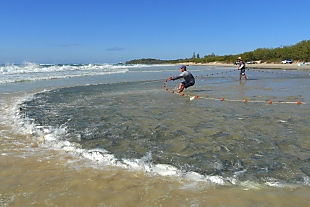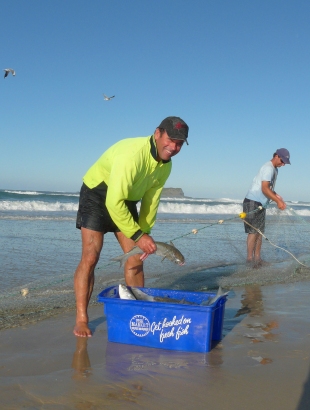
Ocean Hauling Fishery
Share class fact sheets
New rules will apply in most share classes from 1 December 2017. Fact sheets are available for each share class detailing the new share linkage arrangements and proposed new rules.
- Ocean Hauling - General Ocean Hauling
- Ocean Hauling - Garfish Net (Hauling)
- Ocean Hauling - Hauling Net (General Purpose)
- Ocean Hauling - Pilchard, Anchovy & Bait Net (Hauling)
- Ocean Hauling - Purse Seine Net
- FisherMobile Information Sheet
- FisherDirect Information Sheet
What's new
- Fisheries Management (Ocean Hauling on Killick Beach, Crescent Head – Fishing Closure) Notification 2023
PDF, 217.81 KB - Fisheries Management (Crowdy Head Mulloway Closure) Notification 2023 PDF, 199.13 KB
- Fisheries Management (Purse Seine Net Endorsement Holders Eastern School Whiting and Stout Whiting) Order 2019 (PDF, 44.69 KB)
Ocean Hauling Fishery

The Ocean Hauling Fishery is broken up into 7 regions along the NSW coast and targets approximately 20 finfish species using commercial hauling and purse seine nets from sea beaches and in ocean waters within 3 nautical miles of the NSW coast.
The catch is mainly made up of Pilchards (Sardinops sagax) 34%, sea mullet (Mugil cephalus) 30%, Australian Salmon (Arripis trutta) 17%, blue mackerel (Scomber australasicus) 8%, Yellowtail Scad (Trachurus novaezelandiae) 5% and Yellowfin Bream (Acanthopagrus australis) 2% of the total catch.
How these fish are sold depends on the species, some are sold on the domestic market as fresh or frozen fillets, portions or whole fish, some are marketed for export. For example sea mullet roe (fish eggs) is exported to the Asian market.
Managing the Fishery
A comprehensive Fishery Management Strategy (FMS) was prepared for the Ocean Hauling Fishery and approved by the Minister for Primary Industries in February 2003. The Strategy includes a description of the fishery and the management arrangements that apply or are proposed. Before the Strategy was finalised, a draft strategy was subject to a comprehensive environmental impact assessment process, including public consultation, under the NSW Environmental Planning and Assessment Act 1979. The Environmental Impact Statement.
Key Changes to the Management Arrangements

Some of the key changes that were introduced to the Ocean Hauling Fishery as a result of the fishery management strategy include:
- Setting the area of ocean beaches closed to beach hauling at 17 per cent
- Measures to better protect marine habitats
- New programs for better monitoring of fish stocks
- Introduction of catch limits on non-target species and changes to fishing practices to reduce impacts on non-target species.
The Ocean Hauling Fishery is a share management fishery. This means that commercial fishers must hold sufficient shares to be eligible for an endorsement to operate in the fishery. An endorsement authorises the use of specific gear to take fish for sale from certain waters. The rules and regulations that apply to the fishery are contained in the Strategy and within the Fisheries Management (Ocean Haul Share Management Plan) Regulation 2006 (www.legislation.nsw.gov.au) the Fisheries Management Act 1994 No 38 (www.legislation.nsw.gov.au) the Fisheries Management (General) Regulation 2010 (www.legislation.nsw.gov.au) and Fisheries Management (Supporting Plan) Regulation 2006 (www.legislation.nsw.gov.au).
The fishery is managed by input controls which limit the fishing capacity of fishers by indirectly controlling the amount of fish caught. These controls include regulating the size and dimensions of fishing gear used, limiting the number of fishers who have access to each part of the fishery, entry criteria for new entrants and a range of closures including seasonal and weekend closures.
Additionally size limits apply to a number of key species taken in the Ocean Hauling Fishery. The 5 ocean hauling endorsement types in NSW ocean waters are listed below. They specify the methods that may be used and the waters that may be fished.
- General ocean hauling endorsement- Regions 1, 2, 3, 4, 5, 6 and 7
A general ocean hauling endorsement authorises the holder to assist another person who holds an endorsement to take fish, but only if the region specified in that other endorsement is the same as the region specified in the general ocean hauling endorsement. - Hauling net (general purpose) endorsement- Regions 1, 2, 3, 4, 5, 6 and 7
A hauling net (general purpose) endorsement authorises the holder to use a hauling net (general purpose) to take fish in the region of the fishery specified in the endorsement. - Garfish net (hauling) endorsement—Regions 1, 2, 3, 4, 5, 6 and 7
A garfish net (hauling) endorsement authorises the holder to use a garfish net (hauling) to take fish in the region of the fishery specified in the endorsement. - Pilchard, anchovy and bait net (hauling) endorsement—Regions 1, 2, 3, 4, 5, 6 and 7
A pilchard, anchovy and bait net (hauling) endorsement authorises the holder to use a pilchard, anchovy and bait net (hauling) to take fish in the region of the fishery specified in the endorsement. - Purse seine net endorsement
A purse seine net endorsement authorises the holder to use a purse seine net to take fish in any region of the fishery.
Apart from the operation of a purse seine net, at least two appropriately endorsed licensed commercial fishers are required to operate a hauling net, including the removal of any fish in the hauling net.
Catch monitoring
Fishers in the ocean hauling fishery are required to submit records on a monthly basis detailing their catch and fishing effort. The information gathered includes total landed catch for each species, the effort expended (for each method) to take the catch (i.e. days fished) and the area fished.
NSW DPI is committed to research and management programs which contribute to the ongoing sustainability of our fisheries. This research includes annual monitoring and assessment of both the size and age composition of catches from NSW fisheries, including the fishery for pre-spawning sea mullet.
Compliance
Fishery officers located in coastal and inland areas in NSW. They are responsible for coordinating and implementing compliance strategies. These strategies include:
- Maximising voluntary compliance
- Providing effective deterrence for offences
- Providing effective support services.
For more information about Compliance in the Ocean hauling fishery see Ocean Hauling Fishery Management Strategy.
Background
Beach hauling, commonly known as seine netting, was one of the first methods of fishing carried out along ocean beaches by European settlers in Australia. Commercial fishing was first regulated under the Fisheries Management Act 1865. By the end of the 19th century there were regulations restricting the type, size and use of fishing nets, fishing closures and licensing of fishers and boats.
The ocean hauling fishery became a restricted fishery in 1995 and licensed fishers were able to apply for endorsement in the fishery with eligibility based on their historical participation and ownership of fishing gear.
In 2007 the Ocean Hauling Fishery moved from being a restricted fishery to a share management fishery. The share management provisions allow for the allocation of shares to eligible persons. A share management plan for the fishery was prepared in accordance with the agreed goals, objectives and management responses outlined in the management strategy.
Contact
For further information contact the Ocean Hauling Fishery Manager on 1300 726 488.
Want to know more?
- NSW Purse Seine Industry Code of Practice (PDF, 27.5 KB)
- Beach Hauling - Sustainable commercial fishing
- Status of fisheries resources in NSW
- Fisheries Management (Ocean Haul Share Management Plan) Regulation 2006 (www.legislation.nsw.gov.au)
- Ocean Hauling Fishery Management Advisory Committee
- Fishery Management Strategies & Environmental Impact Statements
- Fisheries Management (Purse Seine Net Endorsement Holders Eastern School Whiting and Stout Whiting) Order 2019 (PDF, 44.7 KB)

